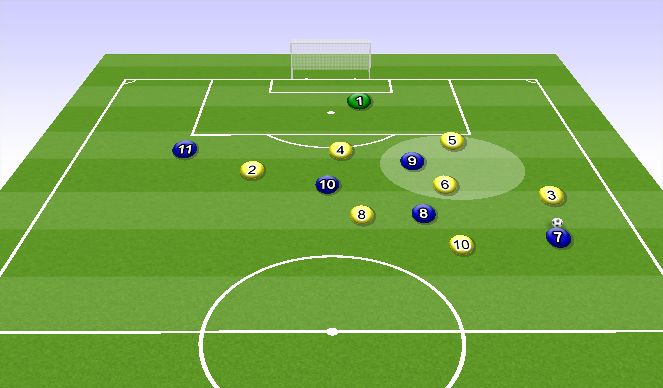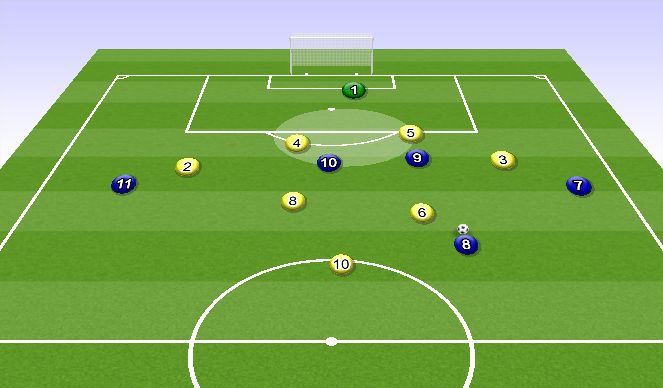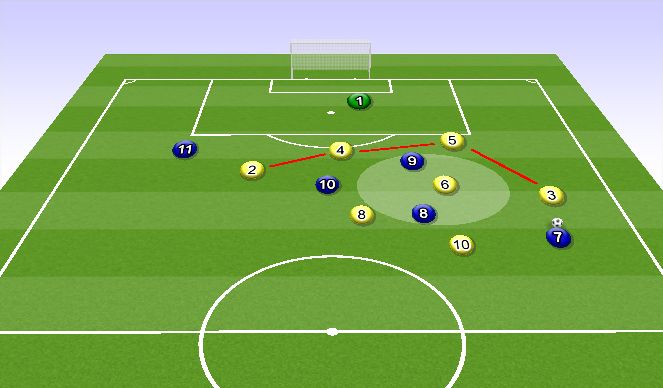Football/Soccer Session (Moderate): Back Four (4) Shape & Organization
Profile Summary

| Name: | Todd Abbey |
|---|---|
| City: | Fayetteville |
| Country: | United States of America |
| Membership: | Adult Member |
| Sport: | Football/Soccer |
Description
Back Four (4) Shape & Organization (Part 1)

See the guidance at the top of this page to understand why you are not seeing interactive Football/Soccer images.

Part 2
Back Four (4) Shape & Organization (Part 2):
Let's look at what happens in moment of the 1st Defender being beaten down the line either off the dribble or a pass.
Is this example, we will have the opposing teams "9" make a wide run into the corner to receive a pass from their "7".
With in this system, having the "5" as the deepest defender, it allows for him/her to see everything in front of them, as well as runs made in behind. It also will give them a better angle, keeping them positioned better between themselves and the goal.
From the initial slide, one could assume that the cover for the "5" once they go to be the 1st defender on the opposing "9", the "4" and "2" would shift over to cover the middle of the pitch once occupied by the "5" and "4", and the "3" would track the opposing "9". The issue with this shift is that by creating too much movement in the remaining backs, they will lose continuity and most times their marks, creating a situation that leads to defensive midfielders having to track back creating gaps and unmarked players for the 9 to play the ball into.
What we want to have happen, is that when the "3" is beaten on the wing and the "5" goes out to pressure, it in the responsibility of the "3" to track back to the "5"'s initial position. This will allow for the "6" to continue to stay in "the hole" and cut off any passes back into midfielders. It allows the "4" to stay central and see any penetrating runs coming across the front of them by the opposing "10" or "8", and it keep the "2" in a position to mark any runs from the back post that may cause issues for a keeper positioned at the near post. Thus, maintaining connection, organization and continuity in front of goal.
Click Play

See the guidance at the top of this page to understand why you are not seeing interactive Football/Soccer images.

Part 3
Back Four (4) Shape & Organization (Part 3):
The last part of the of the Zonal Back 4 is creating a wedge when a ball is played centrally, and the 1st defender needs to be one of the two central backs.
In this situation we want to create "the Swoosh" to the big part of the field. Shifting "the hole" centrally for the "8" (or second "6" in some formations) to cover.
To do this, the "3" on the small side of the field and the "4" located centrally tucks in off either shoulder of the "5" (1st Defender) creating a wedge, making sure that no through balls or penetrating passes can be made into the space the "5" vacated.
At that point, the "2" tucks in creating "the hole" with the "4" and "5" for the "8" to drop into ceasing to allow any penetrating pass to the larger side of the field.
Lastly, by the "4" dropping off the "5"'s shoulder, if the player with the ball (the opposing "9") in this situation is able to play a ball over the top into their running "11", if the keeper can't get there, the "4" is able to track quickly with the "2" covering, as the "5" drops back into position. HOPEFULLY in this time, the initial player that was beaten by the first pass has recovered. (the "6")
Click Play








 Play animation
Play animation Play step-by-step
Play step-by-step Repeat (toggle)
Repeat (toggle) Full Screen
Full Screen Pause
Pause Stop
Stop
Part 1
Back Four (4) Shape & Organization (Part 1):
Organization is a key component to running a zonal back line and requires communication and understanding beyond just the position.
Like any other Defensive Principles, the Zonal Back 4 uses the pressure - cover - balance to the extreme to make sure not only is a defense not allowing penetrating passes, but also guarding against possible through balls, runs and passes that may break down the defensive shape.
We will start with the obvious. The player that is nearest the ball will be the 1st defender and thus pressure and delay. In the example above, as the player with the ball is attacking from the right wing, we see the "3" (left back) step to pressure back to his/her help in the middle of the field.
When this happens, the other 3 backs are to position themselves in the shape of a "swoosh", with the closest center back "5" (2nd Defender) dropping off over the shoulder of the 1st defender and being the furthest defender back. This gives them the ability to keep all runners in front of him/her, but also gives them a better angle on the ball if the 1st defender is beat 1v1 to the outside of the field.
The furthest center back "4" will then shift over towards the middle of the field just ahead of the "5" to be able to create what is called "the hole" for the holding or defensive midfielder "6" to be able to sit in and cut off any penetrating passes to opposing teams "9" or "10".
Lastly, the other outside back will pinch in, and step a bit higher up the field to close off any switches of play that may occur if the opposing teams "7" looks to play a longer pass into the opposing teams "11". And this also allows the 7 to be further up the field in the case his/her team wins the ball and wants to counter-attack through their side of the field.
This shape (the swoosh) is not set up for an offside trap. It is zonal for the purposes of allowing the play to happen in front of them, force the opponent into taking more shots from distance, and not allow a team to penetrate behind the back line. It forces the opposing team to try and hit longer balls over the top, or to play smaller central passes into the defensive help of the midfielders.
Keeping in mind, this example does not have any other central midfielders that will normally be there for help.